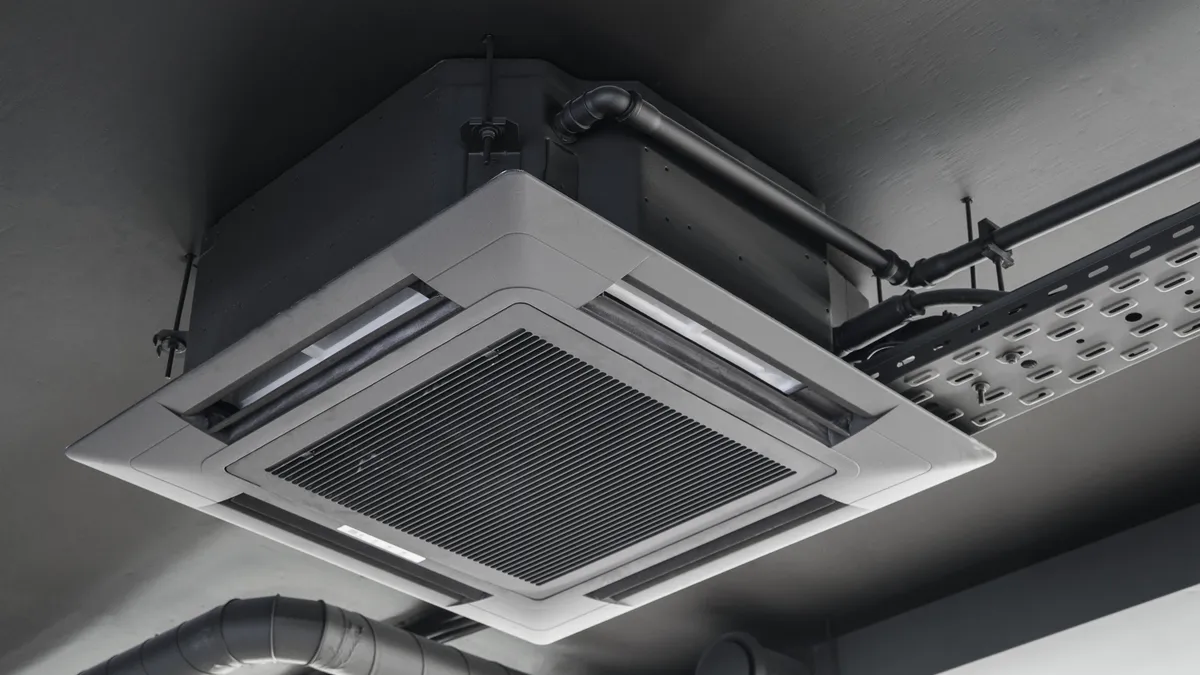Seattle-Tacoma International Airport is one of the largest U.S. airports, serving over 50 million passengers as of 2023. While that travel is largely driven by the airlines, pilots and staff that operate aircraft out of the Pacific Northwest hub, flying in or out of the airport, known to many as Sea-Tac, likely wouldn’t have been possible in the past few years without the airport’s vast fleet of electrified ground support equipment vehicles, or eGSEs.
These eGSEs include belt loaders that shunt luggage into aircraft holds, “pushbacks” that safely guide planes away from the gate, and luggage tugs — vehicles that ferry checked baggage around the airfield. All told, Seattle’s main passenger airport, owned by the Port of Seattle, has more than 400 eGSEs, representing much of its day-to-day ground equipment fleet, Port of Seattle Climate Program Manager Stephanie Meyn told Facilities Dive.
Sea-Tac Airport’s fleet decarbonization program took off in 2014, as many airports and major airlines began to get serious about reducing airfield emissions. The U.S. National Renewable Energy Laboratory, in a 2017 paper on eGSEs in airports, reported that by May 2016, it had counted “at least 22 U.S. airports with significant eGSE projects.” In 2016, Sea-Tac Airport, Philadelphia International Airport and Dallas-Fort Worth International Airport led the way with 230 to 430 eGSEs in use at each airport, NREL said in its paper.
Ground equipment contributes only modestly to airports’ carbon footprints. At Sea-Tac Airport, fleet vehicles have historically accounted for about 10% of scope 1 and scope 2 emissions, against 80% for terminal heating and cooling, Meyn said. But, with the Federal Aviation Administration urging U.S. airports to zero out their carbon emissions by 2050, airport managers nationwide are transitioning to lower-emission fleets now, Meyn said.
Decarbonizing airport-owned vehicles
Many GSEs and eGSEs seen on airport runways and aprons are not owned by the airports themselves. Instead they belong to airlines or ground support contractors, Meyn said.
Airports do own work trucks and other general-purpose vehicles, though. These “workhorses” are mainly light- and medium-duty trucks and SUVs with commercially available electric replacements, such as the Ford F-150 Lightning pickup truck, Adrian Down, environmental program manager at the Port of Seattle said, noting that they generally remain on or near the airfield, reducing range anxiety once they’re electrified. Most wear out within four or five years due to heavy use, so the pace of electrification is relatively fast and the emissions reduction benefits are substantial, according to Down.
Factors like ownership, proximity to the airfield and an ability to reduce range anxiety make electrifying airfield work vehicles an easy lift, Down said. Airport crews see the new vehicles as an upgrade, he added, because their batteries can power onboard equipment “to serve as mobile offices” without letting the engines sit idle.
Many U.S. airports are also working to lower emissions from the heavier-duty vehicles they control, like shuttle buses. However, unlike with light- and medium-duty work vehicles, the short-term solution for heavier-duty vehicles isn’t always full electrification.
In 2018, Philadelphia International Airport added 38 buses running on compressed natural gas, or CNG, to its shuttle fleet, which serves the airport’s employee parking areas, long-term passenger parking and cargo facilities and operations. Philadelphia is now looking at “zero- or low-emission alternatives, such as electric, diesel-hybrid and/or hydrogen fuel cell” buses, said Jessica Noon, City of Philadelphia Department of Aviation sustainability manager.
Like Philadelphia International Airport, Denver International Airport is adopting a longer-term approach to bus electrification. It plans to add 60 CNG buses to its shuttle fleet next February, along with eight all-electric cutaway buses serving the airport’s economy lots, according to Mark Nagel, senior vice president for parking and commercial transportation for Denver International Airport.
A Colorado Department of Public Health and Environment grant supports procurement for those EV buses that will help the airport evaluate the feasibility of EV-powered shuttle buses in its shuttle operations, Nagel said.
Managing electrification bottlenecks
“It’s difficult to find physical locations for some vehicles to park because we’re constantly reassigning spaces."

Adrian Down
Environmental program manager at the Port of Seattle
Fleet electrification will significantly increase power demand at U.S. airports, according to a January 2024 study by Enterprise Mobility, Xcel Energy and Jacobs.
The study projected a fivefold increase in electricity consumption at Denver International Airport, from 2023 levels, reaching more than 235 megawatts by 2050, if the facility meets local and state carbon-neutrality goals, their report says. It notes that the cumulative impact of EV charging is higher, with an estimated 116 MW of power needed by 2050, compared with 94 MW, due to an anticipated increase in EV charging needs for airport employees and the public.
Building out enough charging stations requires creativity at space-constrained airports like Sea-Tac Airport, Meyn said. The air hub’s solution was to build out linear “charging corrals,” each with multiple charge points, extending at right angles from the terminal building into the apron. Between the charging corrals and some additional ports along ramps descending into the lower levels of the terminal building, Seattle found space for 417 eGSE charge points, Meyn said.
But Sea-Tac Airport’s owned work vehicles must charge elsewhere and often don’t have assigned overnight parking spots near Level 2 chargers, causing logistical headaches for airport fleet managers, Down said.
“It’s difficult to find physical locations for some vehicles to park because we’re constantly reassigning spaces,” Down said. This forces fleet managers to be opportunistic about where and how they charge work vehicles, meaning they sometimes have to resort to vehicles’ slower emergency chargers when fixed Level 2 charge points aren’t available, he added.
As airports electrify heavier-duty fleet vehicles and build out charging infrastructure for light-duty EVs at employee, passenger and rental car parking lots, these lots will also require more electrical capacity, Down said.
Adding that capacity demands close coordination with local utilities and adequate supplies of new electrical equipment like transformers, and it’s a heavy lift, according to Philadelphia International Airport’s Noon. “Electrification at a large scale is harder than anticipated, mostly because of the long lead times to obtain new electrical service from our utility, but also [backlogs as long as two years] for new transformers,” Noon said.
Philadelphia has made progress on vehicle electrification, adding 12 EVs to its airfield fleet and installing five dual-port Level 2 charging stations to date, Noon said. Three more Level 2 charging stations are on the way, and the airport is now in the process of “preparing our electrical grid [to install] five Level 3 chargers,” but “we are limited by our current grid,” Noon added.
Denver International Airport representatives have met every month for more than a year with the airport’s utility provider, Xcel Energy “to identify short-term electrical capacity and plan for increasing capacity” in the next 10 to 15 years,” said Scott Morrissey, senior vice president for sustainability at Denver International Airport.
This capacity increase will be critical as the Denver airport works to support its rental car companies’ own decarbonization efforts, Morrissey said. The airport is preparing to build a new consolidated rental car facility, known as ConRAC, that is expected to accommodate a 100% EV fleet, he added.
Do third-party vehicles represent a problem, or an opportunity?
"We have undertaken a process to allocate existing capacity to add the maximum number of electric vehicle charging stations in the short-term as we plan for long-term electrical demand."

Scott Morrissey
Senior vice president for sustainability at Denver International Airport.
Most airport-related ground vehicle emissions come from third-party vehicles owned and operated by airlines, ground support contractors and rental car companies that airports must closely coordinate with as they work toward their carbon-neutrality goals.
Fortunately, those third-party vehicle owners often have carbon-neutrality goals of their own. A report NREL published in 2016 found that Delta Airlines had already electrified 15,000 GSEs, or 15% of its fleet, by early that year, and that 10% of all existing GSEs worldwide were electrified as early as 2013.
Port of Seattle’s Meyn said it has been about 15 years since Alaska Airlines first approached the airport, its primary hub, about full GSE electrification. With the airline’s support, Seattle began adding gateside charging corrals, which made it easier for other airlines to electrify, Meyn said. The Pacific Northwest’s relatively low electricity costs further strengthened the case, she added.
“We have not had to do a lot of heavy persuading of airlines” around electrification, Meyn said. “At this point, when [a non-electric GSE] breaks, the default is to replace it with [an eGSE].”
Philadelphia International Airport has also made substantial progress toward ground support electrification, thanks to airlines’ and contractors’ shared carbon-neutrality goals. The airport’s ground support fleet now includes 26% of eGSEs and the airport has undertaken a broader climate disclosure process to align with American Airlines’ internal climate goals, Noon said.
Still, the pace of electrification isn’t always predictable or uniform across airports. Airlines tend to prioritize emissions reduction measures at hub airports, Meyn said. She compared Alaska Airlines’ early progress at the SeaTac airport with American Airlines, which has fewer scheduled flights and has shown comparatively slower emissions reductions at the airport. American Airlines electrified faster at its largest hub, Dallas-Fort Worth International Airport than at Seattle, she said.
Like airlines, rental car companies generally have internal decarbonization goals, but airports’ strategies for supporting these goals range widely from hands-off to closely involved.
In contrast to its close coordination with airlines, Philadelphia International Airport has “not worked directly with our rental car tenants,” Noon said. However, the airport plans to launch a sustainability committee that will bring its airlines and other tenants together “to collaborate on emissions reductions,” she added.
Denver’s rental car decarbonization strategy is more aggressive. “[Our] rental car partners are interested in electrifying their fleets as quickly as possible, and we have undertaken a process to allocate existing capacity to add the maximum number of electric vehicle charging stations in the short-term as we plan for long-term electrical demand,” Morrissey said.
Denver International Airport is also looking to offset emissions related to passenger transport to and from its rental car facility. The new ConRAC may be served by an electrified automated people mover, or APM, that would replace the current system of rental company-owned shuttle buses and could eliminate roughly 250,000 bus trips each year, according to Amy Edinger, senior vice president for commercial business at Denver International Airport. The ConRAC project could go out for bids later this year, the airport said in an Oct. 2023 news release.
Back in SeaTac, the pace of rental car electrification is being driven by grid considerations and rental car companies’ own business strategies, Meyn and Down said.
For example, Hertz’s much-publicized decision to downsize its EV fleet was likely due to the fact that rental car companies “are super sensitive to resale value, as they make a lot of money [from] selling slightly used vehicles,” Meyn said. Tesla also decided to slash prices on new EVs last year, which alongside higher-than-expected maintenance and repair costs on heavily-used rideshare vehicles, drove a reduction in the residual value of Hertz’s EVs.
While Hertz’s shift could be interpreted as a sign that the industry feels a sense of urgency to electrify, it’s “probably a short-term development,” Down said. In the meantime, he said, the Sea-Tac Airport is still figuring out how to maximize existing electrical capacity for Level 2 charging at its rental car facility, Down said. The airport is making longer term plans to upgrade infrastructure to support more Level 3 chargers and keeping an eye on initiatives like the federally funded Athena ZEV pilot project, which aims to expand fast charging at rental car centers, while minimizing impacts on electrical infrastructure, Down noted.




















